BOSNIA PREPARES TO MARK 11th ANNIVERSARY OF GENOCIDE

BOSNIA TO MARK 11th ANNIVERSARY OF SREBRENICA GENOCIDE
"The duty of Bosnians is not to allow the world to forget what happened one hour away from Berlin and Paris, in the middle of Europe." - Diego Enrique Arria
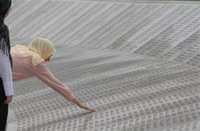 SARAJEVO - The remains of 505 Bosniaks killed in Europe's worst massacre since World War II have arrived in Srebrenica for burial on the 11th anniversary of the slaughter on Tuesday, July 11th.
SARAJEVO - The remains of 505 Bosniaks killed in Europe's worst massacre since World War II have arrived in Srebrenica for burial on the 11th anniversary of the slaughter on Tuesday, July 11th.Srebrenica massacre is the first legally established case of genocide in Europe after the Holocaust.
The remains of the victims, aged between 15 and 78 -- found in numerous mass graves around the ill-fated town where Serb forces killed over 8,100 men and boys -- were to be laid to rest during a solemn religious ceremony.
 On Saturday, hundreds of people, including Venezuela's former ambassador to the United Nations Diego Enrique Arria, lined Sarajevo's main street as a convoy of three trucks carrying the remains headed for Srebrenica.
On Saturday, hundreds of people, including Venezuela's former ambassador to the United Nations Diego Enrique Arria, lined Sarajevo's main street as a convoy of three trucks carrying the remains headed for Srebrenica."The duty of Bosnians is not to allow the world to forget what happened one hour away from Berlin and Paris, in the middle of Europe," Arria was quoted by AFP as telling journalists.
The Srebrenica massacre "is the greatest cover up in the history of the United Nations," he added.
 Srebrenica was supposed to be a UN safe haven, but without air support that never came the lightly armed Dutch soldiers deployed to protect it could have done little to save its Bosniak population.
Srebrenica was supposed to be a UN safe haven, but without air support that never came the lightly armed Dutch soldiers deployed to protect it could have done little to save its Bosniak population.Thousands of relatives of Srebrenica victims and survivors of the massacre were expected to attend the joint funeral at a memorial cemetery outside the eastern town, which already holds 2,000 of those killed.
They were to be joined by the UN chief war crimes prosecutor Carla Del Ponte.
 The Bosniak member of Bosnia's tripartite presidency Sulejman Tihic joined Sunday some 1,000 people who had begun two days ago a march to Srebrenica from the village of Nezuk, some 100 kilometers (60 miles) north, with arrival on July 10.
The Bosniak member of Bosnia's tripartite presidency Sulejman Tihic joined Sunday some 1,000 people who had begun two days ago a march to Srebrenica from the village of Nezuk, some 100 kilometers (60 miles) north, with arrival on July 10.The march was organized in honor of over 10,000 men from Srebrenica who took to the hills, hours before the town fell to Serb forces on July 11, 1995, in a desperate attempt to escape to territory controlled by the Bosniak-led Bosnian government.
Only about a third of them succeeded in reaching the government-controlled town of Tuzla.
The others, exposed to Serbian shelling and automatic weapons fire, had been captured or surrendered and were later killed.
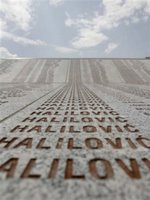 Meanwhile, new victims of the massacre were being unearthed at one of the largest mass graves discovered last month in the village of Kamenica, some 30 kilometers (19 miles) from Srebrenica.
Meanwhile, new victims of the massacre were being unearthed at one of the largest mass graves discovered last month in the village of Kamenica, some 30 kilometers (19 miles) from Srebrenica.Experts said the remains unearthed so far accounted for close to 300 people, identified as Srebrenica Bosniaks by personal documents found with the skeletons. Another 200 were expected to be found on the site as the exhumation work there is to continue for another two weeks.
The grave is one of eight so-called secondary mass graves found in Kamenica. The seven previously exhumed sites contained some 1,000 bodies from the massacre.
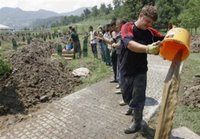 Their bodies were initially buried in a dozen mass graves, but the Bosnian Serbs moved them later to other locations to cover up the massacre.
Their bodies were initially buried in a dozen mass graves, but the Bosnian Serbs moved them later to other locations to cover up the massacre.Some 2,500 Srebrenica victims have been identified by DNA analyses, while 3,500 bags filled with individual human bones exhumed from mass graves and stored in specialized morgue facilities are still waiting to be identified.
Remain at large
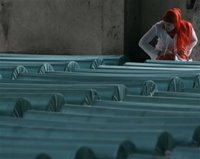 Bosnian Serb wartime leader Radovan Karadzic and his military chief Ratko Mladic, the two people considered most responsible for the massacre, remain at large. The United States government is offering up to $5 million reward for information leading to arrests of Karadzic and/or Mladic.
Bosnian Serb wartime leader Radovan Karadzic and his military chief Ratko Mladic, the two people considered most responsible for the massacre, remain at large. The United States government is offering up to $5 million reward for information leading to arrests of Karadzic and/or Mladic.The pair face charges of genocide for atrocities committed during the war, which claimed over 100,000 victims.
The United Nations admitted partial responsibility for the Srebrenica tragedy, saying it had played too passive a role in the conflict.
Earlier this month a Dutch law firm announced it was to launch a civil case against the UN and the Netherlands seeking damages on behalf of 7,930 relatives of the massacre victims.


<< Home